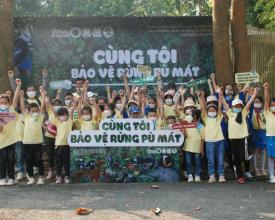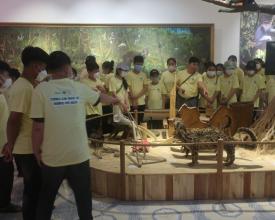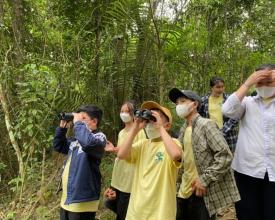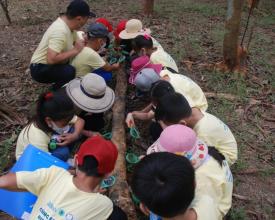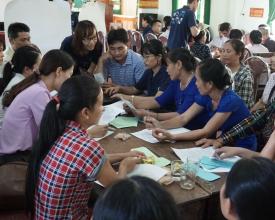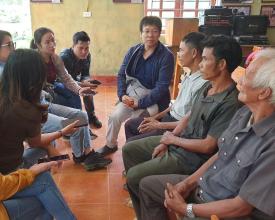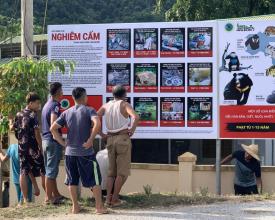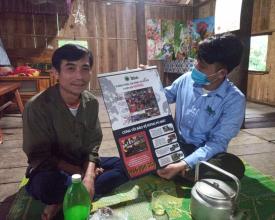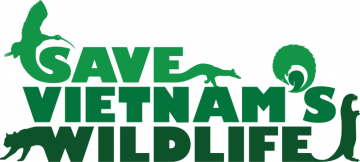
Education outreach to halt biodiversity loss and support the sustainable development of communities around Pu Mat National Park, Vietnam

Indigenous people, local government, wildlife traders, and wildlife consumers all play an important role in the success of conservation goals and strategies around Pu Mat National Park, Nghe An, Vietnam. Local indigenous people are dependent on forest resources and some are also involved in the illegal wildlife trade. To reduce the communities’ adverse impacts on forests, we implemented school programs, community engagement, and behaviour change activities. The program has improved school children's understanding of the importance of Pu Mat National Park and all wildlife within its boundaries. By the end of our project, children were willing to choose jobs that did not impact forests. Local indigenous people were engaged and inspired to stop deforestation; one-third of the working-age people in the villages left the villages to seek employment in factories instead of entering forests and hunting animals, and there was an increase in over 35% of participating stakeholders saying ‘no’ to wildlife consumption.
Context
Challenges addressed
Many ecosystems in Indochina are facing an extinction crisis. A wide range of populations of endemic and keystone species are declining due to the illegal wildlife trade.
- The problem is more challenging when the illegal wildlife trade involves local people, who are often impoverished ethnic minorities
- Since national parks still allow local people to enter forests and collect non-timber products in Vietnam, this could cause severe damage to biodiversity and threaten the existence of wild animals when done for commercial purposes.
- Local people go into forests to set up traps and snares indiscriminately, whereby any species trapped can be taken and sold.
- Many local people originally lived inside the forest. Voluntary relocation policies of the Vietnamese government convinced many communities to live outside of the forest; however, they are still largely depending on forest resources
- The main consumers of wildlife are often wealthy and high-status individuals, including government officials.
Location
Process
Summary of the process
Human activities are the main threat to wildlife in Vietnam, and their impacts often stem from the lack of awareness, knowledge, and negative attitudes towards wildlife. With our education outreach programs, SVW targeted multiple stakeholders from different sectors of the public. Our programs were designed based on the specific needs of each targeted group, and also on the conservation requirements of our key species. Engaging stakeholders with a needs assessment identifies what they respond best to, and follow up interventions exploit those responses to custom-tailor behavioural change activities.
Children are encouraged to take suitable actions to protect the wildlife they love, promising a future generation in the buffer zones with positive attitudes and behaviours towards wildlife. Local communities, in the future, will be provided with alternative livelihoods or be introduced to more labour options to reduce their negative impacts on natural resources. Last but not least, behaviour change programs reduce the demand for wildlife products.
Building Blocks
School program
Raising awareness and educating the community, especially children in the buffer zone of Pu Mat National Park is one of SVW's long-term strategies that aims at forming a future generation with positive attitudes and behaviours towards wildlife while reducing unsustainable exploitation of natural resources. Our program "Join me to protect Pu Mat forests'” is aligned with the environmental education curriculum at schools carried out by the Vietnamese Ministry of Education and Training, as well as general policies of the government in the field of nature conservation and wildlife management. More than 4,500 primary and secondary students in the buffer zone of Pu Mat National Park were engaged in this program, gaining more knowledge, and proudly contributing to the protection of Pu Mat National Park when possible. Visual posters, handbooks, and other materials were distributed to schools to continue spreading the word of conservation.
Enabling factors
The program consists of 5 different activities:
- Social research was conducted before and after the program to assess the impacts
- A student club at each school was established
- A broadcasting program was launched at schools, encouraging students to raise their own voices
- Our one-day field trips took clubs’ members and students who actively participated in the program to Pu Mat National Park to experience wildlife and nature in the Park to inspire and encourage them to take action.
Lesson learned
- The difference in the cognitive level of school children of different ages, especially those in the remote areas should be kept in mind when developing content and materials for the activities. Multiple educational methods should be adopted to create more diverse approaches for students of different ages.
- Severe weather conditions in the local areas can interfere with the conduct of the activities, especially those that require in-person interaction. When these unfortunate events occur, it is best to be flexible and backup plans should be carefully prepared beforehand.
- The complicated and unpredictable outbreaks of the COVID-19 pandemic in Vietnam were the most significant factor that impacted the program. Taking activities to online platforms can be a solution, however, accessibility of students in remote areas should also be considered. Backup plans always should be carefully prepared beforehand.
Resources
Community engagement program
Working with local communities in the buffer zones of Pu Mat National Park is one of SVW’s main focuses, in order to raise awareness, reduce their impacts on forest resources, and inspire them to protect wildlife. We utilise diverse approaches to implement different programs, from holding community engagement workshops and training, placing large billboards around the buffer zones and using self-sustained education outreach tools to encourage local people to take informed actions to protect wildlife.
Enabling factors
- Numerous community workshops were conducted in wildlife strongholds and poaching hotspots around Pu Mat National Park, with the attendance of local villagers
- SVW installed large-size billboards to raise awareness at the entrances to the forest and other areas
- A bilingual radio broadcast about wildlife for the community living in the buffer zone of the park
- A handy awareness-raising toolkit was developed for the Anti-poaching team and Park’s rangers to bring along and use to talk with people during their patrol or meetings with the community
Lesson learned
- A large number of people in the remote areas of the buffer zones are illiterate, therefore all educational materials need to be simple with many images.
- When developing activities, the participation of local communities should be taken into consideration to raise the effectiveness of the community engagement programs.
- After a series of community engagement activities, SVW aims to develop appropriate alternative livelihoods for the local communities.
Behaviour change
Behavioural change is one of our main building blocks to benefit wildlife conservation. This project component aims to change the behaviour of wildlife consumers by identifying key behaviours and using them to reduce demand for wildlife products. Findings of background research on awareness and attitudes of government officials and citizens around Pu Mat National Park towards wild meat consumption and sales were used to develop appropriate behaviour change interventions, drawing attention to the impact of wild meat consumption on health and the negative social perceptions of consuming wild meat. Following implementation of our work, the impact of our messages on avoidance behaviour and attitudes toward wild meat consumption was measured.
Enabling factors
- Interview-based research on wild meat trade/restaurants in the project area and relevant literature fed to behavioural change researchers
- Behavioural change campaign designed and implemented in the project area: a campaign launching event; a billboard and posters campaign were installed in central locations and main roads. Moreover, all of the government officials signed a pledge not to use illegal wildlife.
- Pre- and post-project evaluation to assess initial impacts
Lesson learned
- Project planning should be more carefully considered to avoid overlapping agendas with local government. The team should try to make a detailed plan for requesting approvals and implementation that avoid the government’s regular busy period.
- The content and image used on every campaign material must be considered carefully to minimise controversy and politically sensitive issues. All content and images used for intervention had been considered and adjusted carefully before installation, which followed both recommendations from the consultant team and the government.
- The campaign and its messages should be delivered by more diverse communication mediums to enhance the outreach and effectiveness.
- The material of billboards should be considered carefully to ensure the resistance to extreme weather in Vietnam and unexpected accidents.
Impacts
School Program
-
After the program, 92.13% of the students surveyed correctly answered the question about knowledge of wildlife
-
98% of the club students expressed a choice to not participate in jobs that depend on Pu Mat forests such as logging, forest products, and hunting when they grow up
-
90.38% of the students surveyed were made aware of the activities that they could participate it protect Pu Mat forests after the program
Community Engagement Program
-
One-third of working-age people left the villages where our community engagement workshops took place to seek employment after the Lunar New Year 2019, as the result of strengthening law enforcement and community education workshops.
-
Several large billboards, together with our information toolkits, were reported to help the local Forest Protection Department of Pu Mat National Park increase people’s awareness of wildlife conservation needs and forestry law.
Behaviour changes
-
Participants willing to avoid consuming any wild meat products increased by 36%
-
After the intervention was implemented, an increasing number of people disapproved of wild meat consumption
-
Following the intervention, participants believed that fewer people in Vietnam consumed wild meat and that society was more disapproving of wild meat consumption
-
Wild meat was rated as more likely to cause illness following the intervention than non-wild meat compared to before the intervention
Beneficiaries
Local people
Local authorities (Provincial/District People’s Committee; Provincial/District Forest Protection Department)
National park officials and management board
Business sector e.g., restaurants
Wildlife in Pu Mat National Park
Sustainable Development Goals
Story
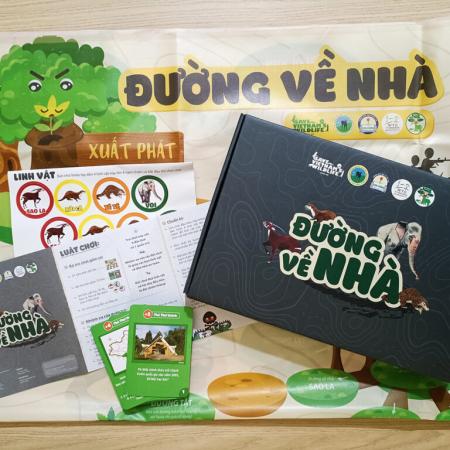
Due to the COVID-19 pandemic, we have been unable to organise assemblies at schools for our annual conservation event. We came up with multiple backup plans, including a board game called “The Way Home” and a writing contest.
Our board game “The Way Home” aims to promote creativity, and interactivity and is hoped to help children have fun while still getting to know useful information about the nature and wildlife of Pu Mat. The game takes students on the journeys of Pangolin, Otter, Saola and Elephant through dangerous traps of hunters in the forest to return home safely. The advantage of the game is that teachers can reuse it many times, for many students of different cohorts. The game received a lot of appreciation from students and teachers. After first playing the game, a student shared with us: “This is the first time that my friends and I got to play a game about wild animals. I really like this game because it looks beautiful, and has a lot of information about nature and wildlife that I can learn from.”
The writing contest that we organised has exceeded our expectations, as roughly a month after launching the contest, we received over 1.000 entries - one-fifth of the total students in the buffer zone of Pu Mat National Park. It was such an incredible outcome for us, as it proved that our program has been far-reaching in the communities surrounding Pu Mat National Park.


